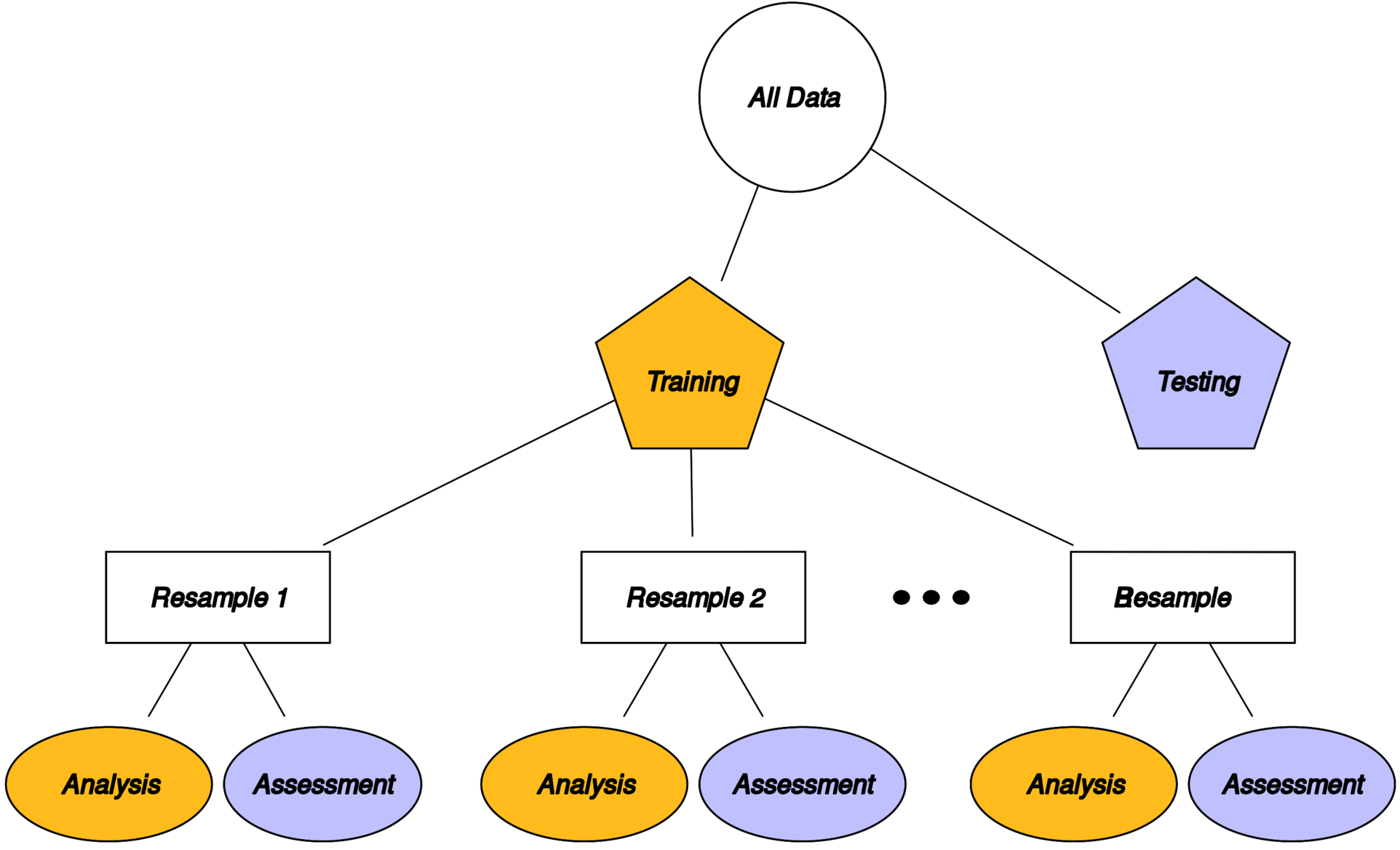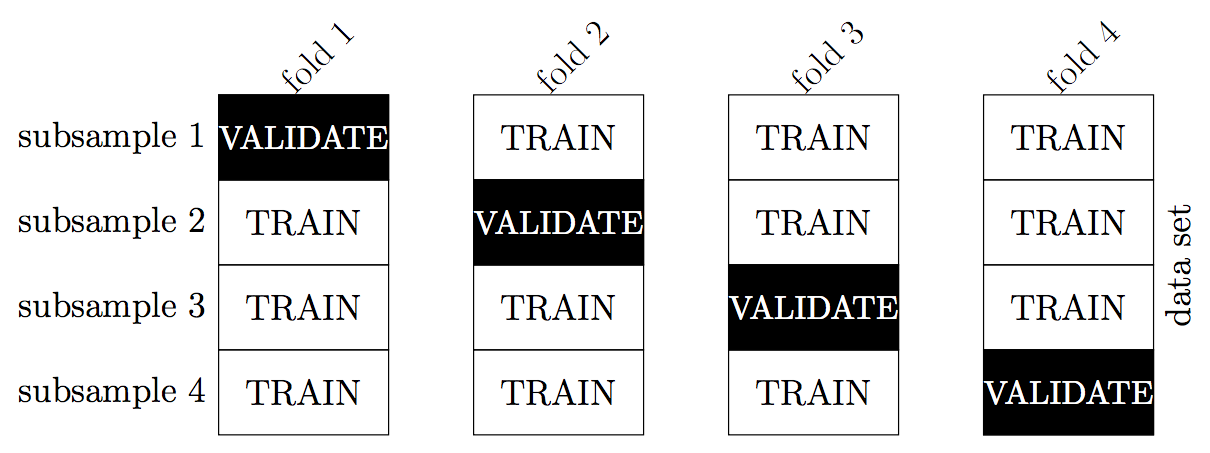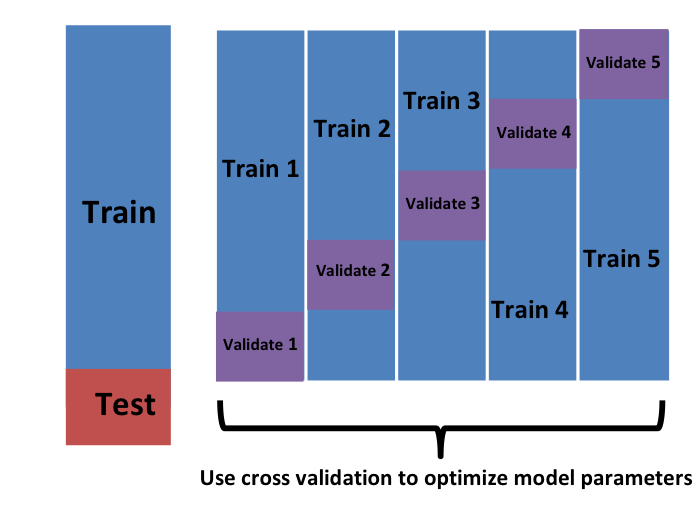Cross Validation and Linear Regression
STAT 220
Resampling methods

Create a series of data sets similar to the training/testing split, always used with the training set
Why not to use single (training) test set

Cross validation

Idea: Split the training data up into multiple training-validation pairs, evaluate the classifier on each split and average the performance metrics
Image courtesy of Dennis Sun
k-fold cross validation
split the data into \(k\) subsets
combine the first \(k-1\) subsets into a training set and train the classifier
evaluate the model predictions on the last (i.e. \(k\)th) held-out subset
repeat steps 2-3 \(k\) times (i.e. \(k\) “folds”), each time holding out a different one of the \(k\) subsets
calculate performance metrics from each validation set
average each metric over the \(k\) folds to come up with a single estimate of that metric
5-fold cross validation
Creating the recipe
5-fold cross validation
Create your model specification and use tune() as a placeholder for the number of neighbors
Split the fire_train data set into v = 5 folds, stratified by classes
5-fold cross validation
Create a grid of \(K\) values, the number of neighbors
Run 5-fold CV on the k_vals grid, storing four performance metrics
Choosing K
Collect the performance metrics
# A tibble: 6 × 7
neighbors .metric .estimator mean n std_err .config
<dbl> <chr> <chr> <dbl> <int> <dbl> <chr>
1 1 accuracy binary 0.987 50 0.00343 Preprocessor1_Model01
2 1 ppv binary 0.999 50 0.00133 Preprocessor1_Model01
3 1 sensitivity binary 0.979 50 0.00586 Preprocessor1_Model01
4 1 specificity binary 0.998 50 0.002 Preprocessor1_Model01
5 2 accuracy binary 0.987 50 0.00343 Preprocessor1_Model02
6 2 ppv binary 0.999 50 0.00133 Preprocessor1_Model02Choosing K
Collect the performance metrics and find the best model
# A tibble: 20 × 7
# Groups: .metric [4]
neighbors .metric .estimator mean n std_err .config
<dbl> <chr> <chr> <dbl> <int> <dbl> <chr>
1 1 accuracy binary 0.987 50 0.00343 Preprocessor1_Model01
2 2 accuracy binary 0.987 50 0.00343 Preprocessor1_Model02
3 11 ppv binary 1 50 0 Preprocessor1_Model11
4 12 ppv binary 1 50 0 Preprocessor1_Model12
5 13 ppv binary 1 50 0 Preprocessor1_Model13
6 14 ppv binary 1 50 0 Preprocessor1_Model14
7 15 ppv binary 1 50 0 Preprocessor1_Model15
8 16 ppv binary 1 50 0 Preprocessor1_Model16
9 17 ppv binary 1 50 0 Preprocessor1_Model17
10 18 ppv binary 1 50 0 Preprocessor1_Model18
11 1 sensitivity binary 0.979 50 0.00586 Preprocessor1_Model01
12 2 sensitivity binary 0.979 50 0.00586 Preprocessor1_Model02
13 11 specificity binary 1 50 0 Preprocessor1_Model11
14 12 specificity binary 1 50 0 Preprocessor1_Model12
15 13 specificity binary 1 50 0 Preprocessor1_Model13
16 14 specificity binary 1 50 0 Preprocessor1_Model14
17 15 specificity binary 1 50 0 Preprocessor1_Model15
18 16 specificity binary 1 50 0 Preprocessor1_Model16
19 17 specificity binary 1 50 0 Preprocessor1_Model17
20 18 specificity binary 1 50 0 Preprocessor1_Model18Choosing K: Visualization

The full process

Image source: rafalab.github.io/dsbook/
Group Activity 1

- Please clone the
ca23-yourusernamerepository from Github - Please do problem 1 in the class activity for today
10:00 Supervised Learning
- Supervised learning: Learning a function that maps an input to an output based on example
inputoutputpairs. - Function: \(\mathrm{y}=\mathrm{f}(\mathrm{x})\), where \(\mathrm{y}\) is the label (output) we predict, and \(\mathrm{x}\) is the feature(s) (input).
- Goal: Find a function that calculates \(y\) from \(x\) values accurately for all cases in the training dataset.
Linear Regression: The Basics
Linear regression fits a linear equation to observed data to describe the relationship between variables.
\[y=\beta_0 + \beta_1x_1 + \beta_2x_2 + \cdots + \epsilon\]
- \(y\) is the dependent variable (what we’re trying to predict),
- \(x_1, x_2, \cdots\) are independent variables (features),
- \(\beta_0, \beta_1, \beta_2, \cdots\) are coefficients, and \(\epsilon\) represents the error term.
Objective: Minimize the differences between the observed values and the values predicted by the linear equation.
Relevant Metrics
\[\text{MSE} =\frac{1}{n} \sum_{i=1}^n\left(y_i-\hat{y}_i\right)^2\]
\[\text{RMSE} =\sqrt{\frac{1}{n} \sum_{i=1}^n\left(y_i-\hat{y}_i\right)^2}\]
\[R^2 = 1 - \frac{\sum_{i=1}^{n} (y_i - \hat{y}_i)^2}{\sum_{i=1}^{n} (y_i - \overline{y})^2}\]
Case study: Bike Share Scheme
Data from a real study on a bicycle sharing scheme was collected to predict rental numbers based on seasonality and weather conditions.
| season | yr | mnth | holiday | weekday | workingday | weathersit | temp | atemp | hum | windspeed | rentals |
|---|---|---|---|---|---|---|---|---|---|---|---|
| 1 | 0 | 1 | 0 | 6 | 0 | 2 | 0.344167 | 0.363625 | 0.805833 | 0.160446 | 331 |
| 1 | 0 | 1 | 0 | 0 | 0 | 2 | 0.363478 | 0.353739 | 0.696087 | 0.248539 | 131 |
| 1 | 0 | 1 | 0 | 1 | 1 | 1 | 0.196364 | 0.189405 | 0.437273 | 0.248309 | 120 |
| 1 | 0 | 1 | 0 | 2 | 1 | 1 | 0.200000 | 0.212122 | 0.590435 | 0.160296 | 108 |
| 1 | 0 | 1 | 0 | 3 | 1 | 1 | 0.226957 | 0.229270 | 0.436957 | 0.186900 | 82 |
| Variable | Description |
|---|---|
| instant | An identifier for each unique row |
| season | Encoded numerical value for the season (1 for spring, 2 for summer, 3 for fall, 4 for winter) |
| yr | Observation year in the study, spanning two years (0 for 2011, 1 for 2012) |
| mnth | Month of observation, numbered from 1 (January) to 12 (December) |
| holiday | Indicates if the observation was on a public holiday (binary value) |
| weekday | Day of the week of the observation (0 for Sunday to 6 for Saturday) |
| workingday | Indicates if the day was a working day (binary value, excluding weekends and holidays) |
| weathersit | Weather condition category (1 for clear, 2 for mist/cloud, 3 for light rain/snow, 4 for heavy rain/hail/snow/fog) |
| temp | Normalized temperature in Celsius |
| atemp | Normalized “feels-like” temperature in Celsius |
| hum | Normalized humidity level |
| windspeed | Normalized wind speed |
| rentals | Count of bicycle rentals recorded |
| variable | Min. | 1st Qu. | Median | Mean | 3rd Qu. | Max. |
|---|---|---|---|---|---|---|
| atemp | 0.079070 | 0.337842 | 0.486733 | 0.474354 | 0.608602 | 0.840896 |
| temp | 0.059130 | 0.337083 | 0.498333 | 0.495385 | 0.655417 | 0.861667 |
| hum | 0.000000 | 0.520000 | 0.626667 | 0.627894 | 0.730209 | 0.972500 |
| windspeed | 0.022392 | 0.134950 | 0.180975 | 0.190486 | 0.233214 | 0.507463 |
| rentals | 2.000000 | 315.500000 | 713.000000 | 848.176471 | 1096.000000 | 3410.000000 |


Data preparation and train-test split
set.seed(2056)
bike_select <- bike %>%
select(c(season, mnth, holiday, weekday, workingday, weathersit,
temp, atemp, hum, windspeed, rentals)) %>%
mutate(across(1:6, factor))
bike_split <- bike_select %>%
initial_split(prop = 0.75, strata = holiday)
bike_train <- training(bike_split)
bike_test <- testing(bike_split)Model specification
Fit the model
Predict on test data
Evaluate the model

Group Activity 2

- Please finish the remaining problems in the class activity for today
10:00